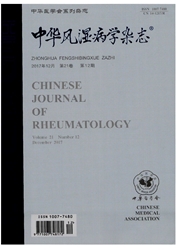

 中文摘要:
中文摘要:
目的研究miR-146a对原发性胆汁性肝硬化(PBC)患者T细胞增殖以及白细胞介素(IL)-2分泌的调控作用。方法荧光定量聚合酶链反应(RT-PCR)检测20例PBC患者和20名健康个体外周血单个核细胞(PBMC)、辅助性T细胞、细胞毒性T细胞、B细胞和单核细胞内miR-146a的表达。将miR-146a表达载体和表达抑制体转染入PBC患者辅助性T细胞内,以抗CD3抗体和抗CD28抗体刺激辅助性T细胞,以CCK-8法检测辅助性T细胞增殖能力,酶联免疫吸附试验(ELISA)法检测培养基内IL-2水平,以RT.PCR法监测辅助性T细胞内miR.146a的表达。2组间的比较采用t检验。结果PBC患者PBMC内miR-146a的表达(0.46±0.20)较健康个体(1.00±0.26)明显降低(t=7.47,P〈0.01)。PBC患者辅助性T细胞和单核细胞内miR-146a的表达(分别为(0.33±0.13,0.56±0.11)较健康个体(分别为1.00±0.14,1.00±0.11))明显降低(t=6.15,4.97;P〈0.01或P〈0.05),但PBC患者与健康个体细胞毒性T细胞(0.98±0.15,1.00±0.12,t=0.22,P〉O.05)和B细胞(0.91±0.06,1.00±0.14;t=0.97,P〉0.05)内miR-146a的表达量之间的差异无统计学意义。抗C03和抗CD28可以诱导辅助性T细胞表达miR-146a(刺激前:1.00±0.18;刺激后:9.12±2.05;t=8.81,P〈0.01kPBC患者辅助性T细胞较健康个体具有较强的增殖能力{PBC:0.35±0.06[吸光度(A值)];健康个体:0.26±0.04(A值);t=2.83,P〈0.05}以及释放IL-2[PBC(686±109)pg/ml;健康个体(512±72)pg/ml;t=2.96,P〈0.05]的能力。miR-146a可以抑制PBC患者T细胞的增殖以及分泌IL-2的能力。结论miR-146a可以负向调控活化的PBC患者辅助性T细胞增殖以及分泌IL-2的能力。PBC的发病机制可能与患者辅助性I生T细胞内miR-146a表达降低、对细胞增殖的抑制作用减弱有关。
 英文摘要:
英文摘要:
Objective To investigate the effect of miR-146a on the proliferation and interleukin (IL)-2 production of T helper cells from primary biliary cirrhosis (PBC) patients. Methods MiR-146a in the peripheral blood mononuclear cells (PBMC), monocytes, T helper cells, cytotoxic T cells and B ceils from 20 confirmede PBC patients and age/sex matched healthy controls were detected by quantitative PCR. By gainand-loss of function, the miR-146a's effect on anti-CD3/anti-CD28 activated T helper's proliferation and IL-2 production ability were measured by CCK-8 approach and enzyme linked immunosorbent assays(ELISA), respectively. Statistical analysis were carried out by t-test. Results PBMCs (0.46±0.20 vs 1.00±0.26; t=7.47,P〈0.01), T helpers (0.33±0.13 vs 1.00±0.14; t=6.15, P〈0.01) and monocytes (0.56±0.11 vs 1.00±0.11; t= 4.97, P〈0.05), hut not B cells (0.91±0.06 vs 1.00±0.14; t=0.97, P〉0.05) and cytotoxic T cells (0.98±0.15 vs 1.00±0.12; t=0.22; P〉0.05) from PBC patients had lower miR-146a expression level than that of healthy controls. Inducible up expression of miR-146a was observed in PBC patients'T helpers stimulated with anti- CD3/anti-CD28 (1.00±0.18 vs 9.12±2.05; t=8.81; P〈O.O1). The activated T helpers from PBC patients had higher proliferative ability EPBC : 0.35±0.06 (A) ; healthy controls : 0.26±0.04 (A) ; t=2.83 ; P〈0.05 ] and increased IL-2 production [PBC: (685.60±109.19 pg/ml)]; Healthy controls: [(512.20±72.26) pg/ml; t= 2.96 ;pg /ml〈0.05 ] than those of healthy controls. For activated T helpers, the proliferation ability, as well as IL-2 production, was enhanced by miR-146a. Conclusion MiR-146a can clown regulate the proliferation and IL-2 releasing of activated T helpers. The reduced miR-146a expression enhances IL-2 production and promotes proliferation of T helper of PBC patients, thus, may be involved in the pathogenesis of PBC.
 同期刊论文项目
同期刊论文项目
 同项目期刊论文
同项目期刊论文
 Effect of the polymorphisms of tumor necrosis factor-alpha gene on the susceptibility to primary bil
Effect of the polymorphisms of tumor necrosis factor-alpha gene on the susceptibility to primary bil Contribution of monocytes Siglec-1 in stimulating T cells proliferation and activation in atheroscle
Contribution of monocytes Siglec-1 in stimulating T cells proliferation and activation in atheroscle Analysis of altered microRNA expression profiles in peripheral blood mononuclear cells from patients
Analysis of altered microRNA expression profiles in peripheral blood mononuclear cells from patients The Role of Siglec-1 and SR-BI Interaction in the Phagocytosis of Oxidized Low Density Lipoprotein b
The Role of Siglec-1 and SR-BI Interaction in the Phagocytosis of Oxidized Low Density Lipoprotein b A dyspnea patient with abnormal prolonged prothrombin time and activated partial thromboplstin time,
A dyspnea patient with abnormal prolonged prothrombin time and activated partial thromboplstin time, 期刊信息
期刊信息
